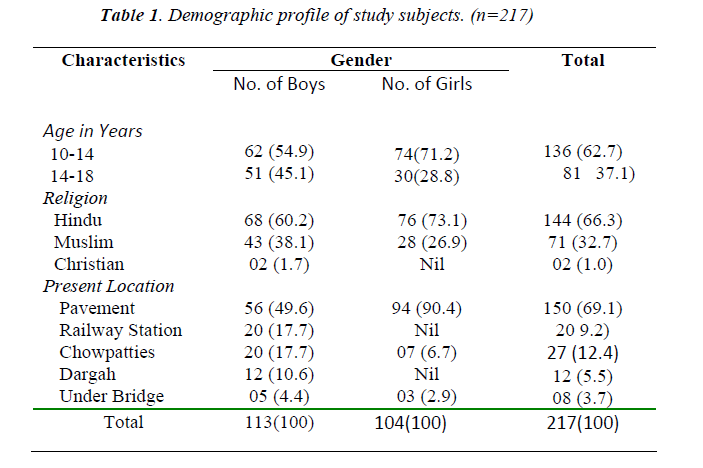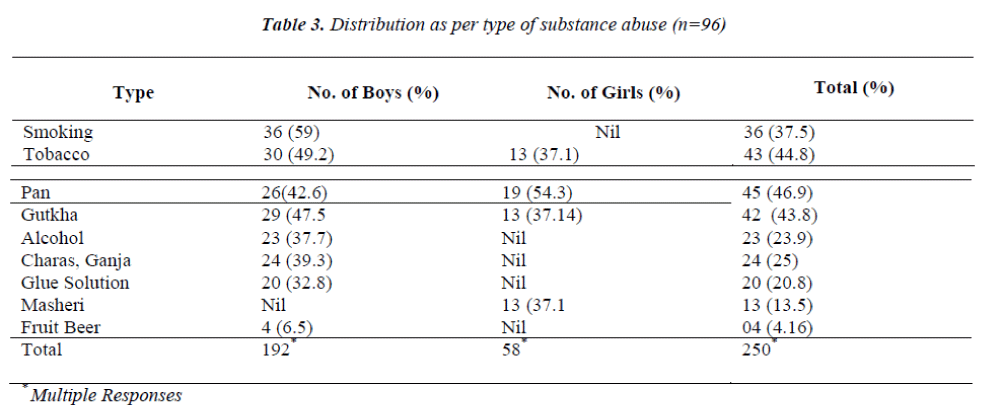- Biomedical Research (2011) Volume 22, Issue 4
Street children of Mumbai: Demographic profile and substance abuse
Poonam R.Naik1*, Seema S. Bansode Gokhe2, Ratnendra R.Shinde3, Abhay S.Nirgude41Department of Community Medicine, Kamineni Institute of Medical Sciences, Sreepurum, Narketpally. Nalgonda dis-trict, A.P.State. India
2Department of Preventive and Social Medicine, Seth G.S.Medical College & K.E.M.Hospital, Parel-Mumbai-Maharashtra State, India
3Department of Preventive and Social Medicine, Seth G.S.Medical College and K.E.M.Hospital, Parel, Mum-bai,.Maharashtra State, India
4Department of Community Medicine, Kamineni Institute of Medical Sciences, Sreepurum, Narketpally, Nalgonda dis-trict. A.P.State, India
- Corresponding Author:
- Poonam R. Naik
Department of Community Medicine
Kamineni Institute of Medical Sciences
Sreepurum, Narketpally-508254. Nalgonda District
Andhra Pradesh, India
Accepted Date: July 17 2010
Abstract
Street children are predominantly an urban phenomenon. India has largest number of street children. Preventing drug abuse in street children is big challenge to public health ex-perts. Demographic profile and substance abuse among the street children in two shelter homes of Mumbai have been studied. A cross-sectional study was undertaken during Febru-ary 2003 to May 2004 by involving 217 street children from Anmol and Salaam Balak shel-ter homes by universal sampling method. Oral informed consent was taken from both the shelter home authorities. Data was collected by conducting face to face interview with street children by using pre-designed questionnaire and was compiled and tabulated and pre-sented in percentages & proportions. Chi square test was used to study the factor associated with substance abuse. Majority i.e. 113 out off 217 subjects were boys and mostly belongs to Muslim religion (144). The mean age of substance abuse for males was 11.3 years old and 8.83 years old for females. Overall substance abuse was reported by 96(44.2%) subjects. Only 5 subjects reported substance abuse who were continuing school education as com-pared to school dropouts (52).This difference found to be significant by chi square test. Study reveals high prevalence and early initiation of substance abuse among street children. Continuing school education has beneficial role in prevention of substance abuse
Keywords
Street children, substance abuse, Mumbai
Introduction
A street children is any minor for whom the street has become his or her habitual adobe and place of work and who is without adequate protection. There is no reliable data regarding the exact number of street children in In-dia, however recent analysis estimated that there are 1,00,000 street children in New Delhi,1,25,000 in Kol-kata, and 1,50,000 in Mumbai.[1]
According to the World Health Organization (WHO), substance abuse is "persistent or sporadic drug use incon-sistent with or unrelated to acceptable medical prac-tice"[2]. In a milieu where social and peer influence are critical and drugs are easily available, drug use becomes one aspect of the child's developmental process and even a part of life. The present study was carried out to study the demographic profile and substance abuse among street children of Mumbai.
Materials and Methods
A cross-sectional study was undertaken to study the demographic profile and substance abuse among the street children in two shelter homes of Mumbai.Anmol shelter homes (day care & residential) caters to street girls only and Salaam Balak (day care) caters to both street boys & girls. Subjects were selected from the street children attending the open house programme of Anmol and Salaam Balak shelter homes. The study was conducted during February 2003 to may 2004.A total of 217 subjects which includes 113 boys and 104 girls belonging to adolescent age group i.e. from 10 years to less than 18years were selected by universal sampling method. Data was collected by conducting face to face interview with street children by using pre-designed questionnaire at both the shelter homes during the open house programme. In-formed consent was taken from both the shelter homes before start of the study. Data was compiled and tabulated and presented in percentages & proportions. Chi square test was used to study the factor associated with substance abuse.Results
ut of the 217 study subjects interviewed 113 (52.1%) were boys and 104 (47.9%) girls. The mean age of study subjects for boys was 13.96 years and girls 13.91 years. Majority of children belong to Hindu religion 144 (66.3%) followed by Muslim religion 71 (32.7%).Most of the boys (49.6%) and girls(90.4%) were presently located in pavements, followed by 17.7% boys and 6.7% girls were located at Chowpatties. [Table1].
A total of 96(44.23 %) subjects admitted to substance abuse with overall males abusing more 61 (63.54 %) than females 35 (36.46 %) [Table 2]. The mean age of sub-stance abuse for males was 11.3 years old and 8.83 years old for females. The most common substances used by boys were smoking 36(59%), tobacco 30 (49.2%), Gutkha 29(47.54 %), Charas, Ganja 24 (39.34 %), and alcohol 23(37.7 %).In case of girls pan 19(54.3%) tobacco 13(37.1%),Gutkha 13(37.1%) were found to be the com-mon substance abuse . Also 20 (32.8%) boys and 13(37.1) girls admitted that they use glue solution and Masheri respectively as these substances are cheap and easily available [Table 3].
Peer pressure (86.9 %& 51.4%), inquisitiveness (70.5% and 45.7%) were the main reasons to initiate substance use in both boys and girls respectively [Table 4]. Substance use was more common in never enrolled (39) and school drop-outs groups (52) as compared to those who continued education (05) and this association found to be statistically significant by application of chi square test [Table 5].
Discussion
The median age of substance abuse for males was 11.3 years old and 8.8 years old for females. The study done by .Malhotra et all among street children of Delhi observed that he most common age for initiation of tobacco was between 8 and 10 years with 60.9% of the children smoking and 64.5% consuming a smokeless form of tobacco before 10 years of age [3]. The minimum age at starting substance use in study done by Deepti Pagare et all was as low as 5.5 years [4]. However the study done by Om P Panigrahi et all among adolescents in urban slums of Sambalpur found that the median age of sub-stance abuse for males was 15.09 years old and 15.29 years old for females [5].Study done by Basu et all about inhalant abuse among adolescents observed that most of the cases started inhalant abuse during early adolescence and had decline in scholastic performance [6]. These observations reveal early initiation of substance use among street children which makes them more vulnerable and high risk group. A higher percentage of Muslims (32.7%) than the National figure of 12% (Census of India, 1991) was seen, this is similar to what was reported by Agni-hotri P among Street boys of Delhi [7] .
The present study reveals the prevalence of substance abuse to be 44.23 %, which lower than that reported in street children of Delhi [4] and higher than that reported by Abhay M.Gaidhane et all among street children of Mumbai [8]. WHO project undertaken in 1993 among 550 str eet children from 10 cities throughout world reveals that the most widely used substance were those which were cheap and easily available which includes alcohol, tobacco, cannabis, glue, solvents and pharmaceuticals [9]. Study done among street children of Bangalore revealed that by adolescence the street children have been exposed to many drugs, especially those easily available or associated with work - industrial glues, petrol, cannabis, tobacco and alcohol [10]. Study done by Basu et all reported that all subjects except one abused typewriter erasing fluid and thinner [6]. These observations support the findings of our study [Table 3].
Higher school dropout rate was reported by Agnihotri P [7].In our study majority of substance abusers either never went to school (40.6%) or was school dropouts (54.2%) as compared to those who continued education (5.2%).This association found to be statistically significant[table 5]. This factor needs consideration while devis-ing preventive interventions against substance use. The most common reason for initiation of tobacco was peer pressure (94.1%) followed by curiosity (17.6%) and pressure by relatives (8.8%) as reported by C Malhotra et all [3].Our study also found Peer pressure (86.9 %& 51.4%), inquisitiveness (70.5% & 45.7%) as the main reasons to initiate substance use in both boys and girls respectively.
Conclusions
This study reveals wide use of easily available and cheap substances by street children which points out the neces-sity for a comprehensive strategy to curb the problem. Legislation on substance abuse has been vociferated loudly but still appears to be a mirage. Hence, a very pragmatic approach to containing the problem would be improved information education communication activities especially directed toward street children and their family members. The study findings have been shared with the two shelter homes. The shelter home authorities should use the period of detention of children to implement fo-cused preventive interventions against substance use. Ef-forts should be made to motivate and help street children to continue their education.
References
- Sandhya K. Street Children: Current Indian Scenario. Paediatrics Today 2009; 12: 127-33.
- WHO. Lexicon of alcohol and drug terms. Geneva: World Health Organization; 1994.
- Malhotra C, Malhotra R, Singh MM, Garg S, Ingle GK. A Study of tobacco use among street children of Delhi. Indian Journal of Community Medicine 2007; 32: 58-59.
- Pagare D, Meena GS, Singh MM, Saha R. Risk Factors of Substance Use among Street Children from Delhi. Indian Pediatr 2004; 41: 221-225
- Sarangi L, Acharya HP, Panigrahi OP. Substance abuse among adolescents in urban slums of Sambalpur. In-dian J Community Med 2008; 33: 265-267.
- Basu D, Jhirwal OP, Singh J, Kumar S, Mattoo SK. Inhalant abuse by adolescents: A new challenge for In-dian physicians. Indian J Med Sci 2004;58: 245-249
- Agnihotri P. Street boys of Delhi: A study of their fam-ily and demographic characteristics. Indian J Med Sci [serial online] 2001 [cited 2009 Dec 22]; 55:543-548. Available from: http://www.indianjmedsci.org/text.asp?2001/55/10/543/12037.
- Abhay M. Gaidhane, Quazi Syed Zahiruddin, Lalit Waghmare, Sunita Shanbhag, Sanjay Zodpey. Sub-stance abuse among street children in Mumbai. Journal Vulnerable Children and Youth Studies 2008; 3: 42 -51.
- WHO. Bridging the gaps, The World Health Report 1995, Report of the Director General.p-22.
- Benegal V, Kulbhusan, Seshadri S, Karott M. Drug abuse among street children in Bangalore. A project in Collaboration between NIMHANS, Bangalore and the Bangalore Forum for street and working children, Monograph funded by CRY; 1998.




